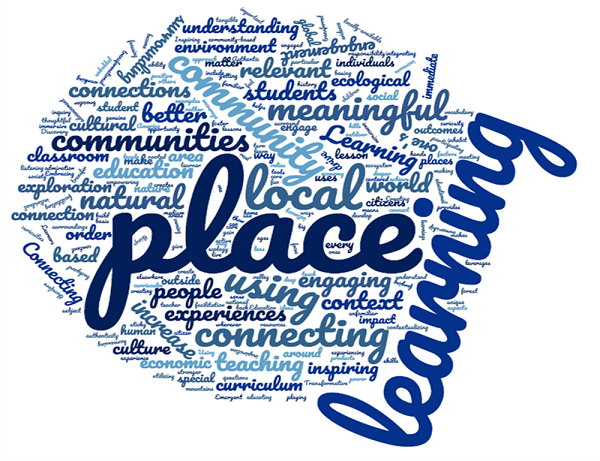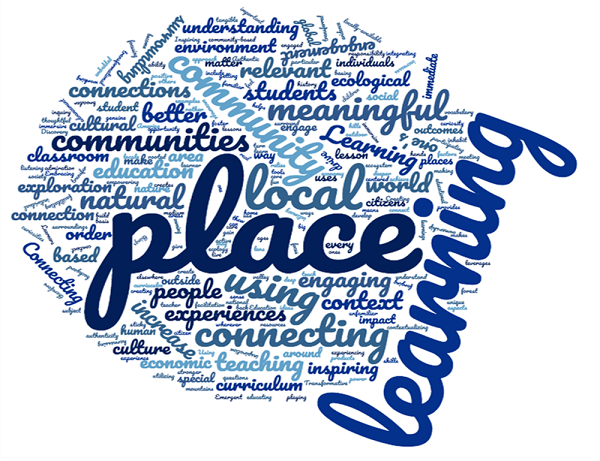
Like a real-world version of Twitter, the Pecha Kucha presentations at the annual Place-Based Education Symposium on April 28th at Teton Science Schools were a rapid fire immersion in how learning can be deeply embedded in communities. The Pecha Kucha, along with longer presentations, table displays, and a keynote speaker, are the building blocks of the symposium. With themes of climate, broadening the interpretation of place-based education, tools of the trade, and identity, faculty, staff, and community members shared successes and challenges to accelerate our collective understanding of place-based education. The TSS Framework of Community Leadership, Intentional Culture, and Educational Approach connected all of the presentations and were highlighted in many.
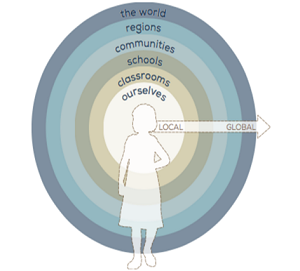 Our Educational Approach, defined by the six principles of place-based education, connected many of the collective stories of the evening. Local to Global Context emerged through presentations on Mindfulness and Climate Change, in which Field Education lead instructors connected mindfulness practices with empathy towards people experiencing the impacts of climate change. A middle school teacher at Journeys School shared a project entitled The Food Detective, a month-long inquiry into sources and production of food that culminated in a lunch designed and produced for the entire school.
Our Educational Approach, defined by the six principles of place-based education, connected many of the collective stories of the evening. Local to Global Context emerged through presentations on Mindfulness and Climate Change, in which Field Education lead instructors connected mindfulness practices with empathy towards people experiencing the impacts of climate change. A middle school teacher at Journeys School shared a project entitled The Food Detective, a month-long inquiry into sources and production of food that culminated in a lunch designed and produced for the entire school.
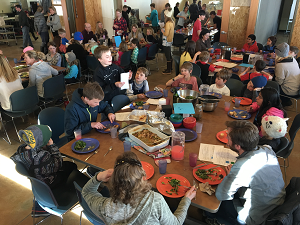 The presentations that focused on the principle of Learner-Centered, focused on increasing relevance for and agency in students, reminded participants to begin with self as we connect learning to place. Building Community and Empathy in Field Groups, presented by a Field Education instructor, articulated how to quickly build relationships with students and understand diverse backgrounds, while a teacher at Teton Valley Community School shared experiences with young children’s explorations in The Process of Wandering and Wondering.
The presentations that focused on the principle of Learner-Centered, focused on increasing relevance for and agency in students, reminded participants to begin with self as we connect learning to place. Building Community and Empathy in Field Groups, presented by a Field Education instructor, articulated how to quickly build relationships with students and understand diverse backgrounds, while a teacher at Teton Valley Community School shared experiences with young children’s explorations in The Process of Wandering and Wondering.
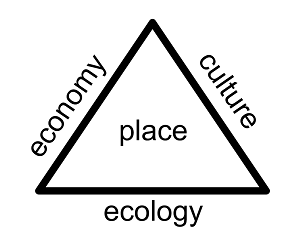 Inquiry-Based allows for learning to be grounded in observation, questioning, predicting, and collecting data to understand different lenses of place. Practicing what we preach, Climate Change: The Place Triangle in Action demonstrated how an inquiry into the local ecology and economy can lead to a broader understanding of climate change. Natural Systems as a Model for Understanding Leadership shared how community leadership development was modeled after direct inquiry experiences in the Ohio University Fellows program.
Inquiry-Based allows for learning to be grounded in observation, questioning, predicting, and collecting data to understand different lenses of place. Practicing what we preach, Climate Change: The Place Triangle in Action demonstrated how an inquiry into the local ecology and economy can lead to a broader understanding of climate change. Natural Systems as a Model for Understanding Leadership shared how community leadership development was modeled after direct inquiry experiences in the Ohio University Fellows program.
Another core principle described in our Educational Approach competency in the Framework is Design Thinking, which provides a systematic approach for learners to make meaningful impact in communities. Self, Community, and the Earth: Using Mindfulness to Promote Sustainability at Every Level connected mindfulness, social justice, and environmental stewardship within Field Education programs. Participants wrestled with how advocacy connects with place-based education in The Role of Advocacy in Place-Based Education.
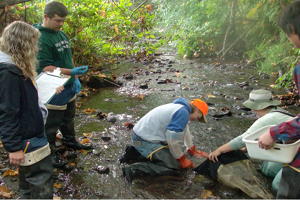 Community as Classroom emerged from many presentations. Highlights included Francisco Guajardo’s keynote talk on understanding history and culture through family, high school curriculum, and the first public bilingual university in the country. His presentation exemplified the key cultural component of the place triangle that, along with the ecological and economic components, provide lenses to understand communities. An AmeriCorp presenter shared experiences working with diverse cultures through a presentation entitled Including Native Peoples in Place-Based Curriculum, while the vision of Place Schools, a public, rural, K-12 school model based on the principles of place-based education was shared through The Power of Place in Rural Education: A Model for School Transformation.
Community as Classroom emerged from many presentations. Highlights included Francisco Guajardo’s keynote talk on understanding history and culture through family, high school curriculum, and the first public bilingual university in the country. His presentation exemplified the key cultural component of the place triangle that, along with the ecological and economic components, provide lenses to understand communities. An AmeriCorp presenter shared experiences working with diverse cultures through a presentation entitled Including Native Peoples in Place-Based Curriculum, while the vision of Place Schools, a public, rural, K-12 school model based on the principles of place-based education was shared through The Power of Place in Rural Education: A Model for School Transformation.
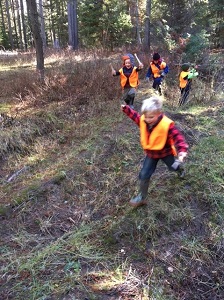 Finally, Interdisciplinary Approach focuses on how place-based education inherently connects many traditional disciplines. Highlighting Hands-on Learning, presented by the Teton Raptor Center, connected raptor ecology with how to take an active role in the community. Documentation and Connection to Place shared how documentation of children’s experiences at the Jackson Hole Children’s Museum helps to connect those learners to an integrated and interdisciplinary understanding of the world.
Finally, Interdisciplinary Approach focuses on how place-based education inherently connects many traditional disciplines. Highlighting Hands-on Learning, presented by the Teton Raptor Center, connected raptor ecology with how to take an active role in the community. Documentation and Connection to Place shared how documentation of children’s experiences at the Jackson Hole Children’s Museum helps to connect those learners to an integrated and interdisciplinary understanding of the world.
Participants left inspired with new ideas to connect learning to place through the TSS Framework. The inclusion of community partners this year foreshadows our goal of beginning to create a community-wide symposium with many different participants. The organization, driven by a newly articulated mission of inspiring curiosity, engagement, and leadership through transformative place-based education, is clearly committed not only to re-thinking education to help learners understand and impact local places, but also to creating a culture of lifelong learning through our diverse program offerings.

